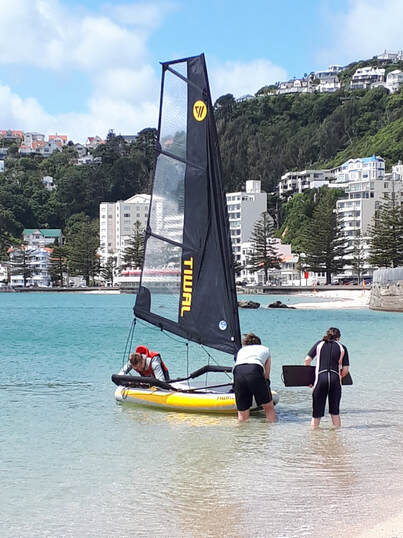 Hello TIWAL owners, I am in lockdown in Auckland, so I join the majority of you also in some sort of lockdown. I spoke too soon. So, in the spirit of feeling useful, enlightened, and part of the TIWAL community, read on. When I tried a small foiling boat for the first time I did more swimming than sailing. I thought I was a good sailor! I needed to get back to basics again - and learn more about apparent wind. Maybe it will help me with my other sailing too? Have you ever struggled to get sailing? Here is an explanation of apparent wind and why you need to know about it. Apparent wind is the wind we feel and experience when we are in motion. It's a combination of the actual wind (true wind) that blows over land and sea and the wind created by our moving forward. Think of your bike when it is moving fast. That wind you feel on your face is apparent wind. Even if there is a slight wind at your back (the true wind) you can still feel the wind coming from in front of you (the apparent wind). Now, increase that following wind and, at the same time your bike speed, you'll start feeling less of a headwind coming at you. That's because apparent wind is a combination of the true wind and the wind created by speeding forward. The important thing to realize here, however, is that as you travel faster the apparent wind not only increases in speed but it also changes the angle of the wind. Now relate that to sailing: the wind we feel on our face as we are sailing is the same wind the sail feels - we sail to the apparent wind, not to the true wind. Have you ever struggled to get moving in very light winds? Try these two things: 1. Adjust your steering to sail at a reaching angle (across the wind) to increase your boat speed. Once you have increased your boat speed you can then point higher into the wind. You will also be able to steer more easily with more water flow over your centreboard and rudder. 2. The wind hits the sail at a different angle up high, and that means you adjust your sail accordingly - ease the mainsheet to ’twist’ the sail at the top. When there is almost no wind, the layer of air close to the water is very slow. The wind higher up maybe 2 knots more. So you may have 0.5 knots at the bottom of your sail and 2.5 knots at the top of your sail. Slow wind speeds on the surface mean if you are sailing upwind, beam reaching or broad-reaching it will mean that the apparent wind will be almost directly ahead of you at your eye level, but at the top of the mast the wind will be coming more from the side so there will be a massive twist (change of direction in the apparent wind). If you want to enjoy a smooth sailing experience or an adrenaline filled ride, book a sail in a TIWAL Inflatable Sailing Dinghy and get on the water in 20 minutes.
0 Comments
As a coach at Sailability Auckland I am privileged to witness a special thing. Nick came to to Sailability for the first time after having been stuck inside for weeks on end; silently rolling his wheelchair from the TV to the window and back again, all day long.
The first time Nick got into a boat by himself he wanted to do everything perfectly, he worried he wasn’t good enough and he got frustrated with himself when he wasn’t able to do a manoeuvre the way he wanted to. Then he sailed into the wide open ocean he realised it was just him, and his boat and the wind . The feeling of freedom hit him. It was being in nature, a feeling of adventure, a sense of fulfilment and independence. I heard a shout from him: ‘This is my s***!!!!!’ This is the story of four people who also 'found their s***’ on their TIWAL! Jocelyn is 69 years old and she was looking for the one thing which would take her sailing again while allowing her to be independent. Jocelyn first saw the TIWAL at the Sanctuary Cove Boat Show on the Gold Coast and she knew straight away it was ‘just what I had been looking for’; a lightweight boat to handle, a comfortable deck and easy rigging. It was love at first sight! Jocelyn lives on Waiheke Island. She rolls her boat down the driveway to the water in her bathing suit and lifejacket, puts the mast up by herself and wheels her boat to the water. Stephen had just recovered from a serious illness which left him weak and unfit. He was embracing his shot at life and wanting to try learning to sail. He first saw the TIWAL online and saw it was easy to rig, easy to learn in, easy to get back on if he capsized. Now he thinks his TIWAL is ‘just the best’ and he is out in it on Lake Taupo at every opportunity. He sails the TIWAL 3 with the smaller sail while learning, and hopes to take it to the lakes in the South Island later this year. Paul, 72, wanted to feel inspired to get on the water again, to race again. He had owned many yachts in the past but wanted sailing to be easier, cheaper, without the hassles of maintenance. He first saw the TIWAL at the Sydney Boat Show and he found something which actually met all his needs. He just needed to see if he could sail it and after a quick demo at Rose Bay, he knew he could manage it himself. Paul sailed his TIWAL in many places on holidays around NSW, and now races every Saturday at Concorde Ryde Sailing Club. In his words ‘it is just so easy!’. Toby wanted to learn sailing and he saw the TIWAL online. He has a young family, a high pressure job but loves fitting all sorts of adventures into his spare time. He wants a boat he can put in his car, go for a sail and be back home; all within 3 hours. Toby sails on the Gold Coast Broadwater and enjoys continuing to improve his sailing skills. The TIWAL can cater for a range of ages, abilities and experience. Whether you want a relaxed cruise or an adrenaline filled ride, the TIWAL is for you! These sailors I have mentioned and the TIWAL Team are all happy to share their TIWAL experiences with you. Take the plunge and start your TIWAL journey. Ask us for support - we are here to help! |
Melinda HenshawI am a New Zealand sailor who learned to sail in the beautiful Malborough Sounds and then went onto represent NZ at the 2000 Olympics. Archives
December 2023
Categories |



 RSS Feed
RSS Feed
